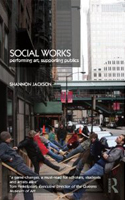No artist is an island, says faculty author Shannon Jackson
Four years ago artist and activist Paul Chan staged a production of Samuel Beckett’s Waiting for Godot in the Katrina-ravaged Ninth Ward of New Orleans.
When one actor urged another to action with the words, “It is not every day that we are needed. But at this place, at this moment of time, all mankind is us, whether we like it or not,” the context proved the point.
The audience was made up of people still waiting for government assistance to rebuild their homes and lives. In this case, the theater piece itself commented on support systems that either came through, or did not.

Art that looks directly at the institutions that surround and support our lives—for better or for worse—is the subject of the book Social Works: Performing Art, Supporting Publics (Routledge, 2011) by Shannon Jackson, professor of Theater, Dance and Performance Studies.
All artwork is collaborative, Jackson argues. Even the sparest monologue requires a support team to work together toward the performance. Artwork is also, she says, often perceived as an expression of social resistance.
“There has been a focus in art that figures political agency as equal to disruption,” Jackson said at an April reception for the new book. “As artists we haven’t been allowed to think about the maintenance, the coordination and the care required to do our work and to sustain social life in general. In writing this book, I wanted to think about how those acts of maintenance could be politically radical as well.”
Jackson is director of Berkeley’s Arts Research Center, which fosters individual and collaborative research projects. Her background is in theater, but as a scholar she has worked with artists from all disciplines. It was this experience, and watching the growth of interdisciplinary art practice, that prompted her to consider the complexities of supporting performance and art installation.
“A visual art curator might have been trained in a particular way, but then a certain kind of hybrid artist comes to town and needs them to secure a street permit or to do a casting call,” Jackson said. “Or the stage manager in the theater is being told that she has to set up an installation in the lobby. Suddenly all of the ushers and box office managers have to be differently trained about how to run the house.”
In a certain sense, Social Works argues that no artist is an island. Consider, Jackson urges, “the nuts and bolts that attach the painting to the wall. Taken to another level, Jackson says, no artist works entirely outside of his or her society. Judith Butler, professor of Rhetoric and Comparative Literature, interviewed Jackson at the book reception. This notion of artistic interdependency, she said, can be complicated.
“Social Works calls into question the assumption that art is distinct from the outside world,” Butler said. “Artists often define themselves in opposition to social norms. But as Shannon has argued, social norms can be confining but they can also be productive.”
Like the production of Waiting for Godot in New Orleans, some art pieces are less able to deny that they need a supporting apparatus than others. But Jackson’s book looks at works that pose questions about the relationship between art and systems—governmental or otherwise.
“I am not saying that interdependence always feels good,” Jackson said. “It is knotty, it is tangled, it is inconvenient. There is nothing more annoying than a stage manager asking you to put your clothes away in the right place. And similarly we can all find ourselves complaining about the bureaucracy of many social systems. But it is also hard to imagine a world without systems that coordinate and care for the public good. These processes inconvenience us sometimes, but they also produce the cultural life that we say we want.”
